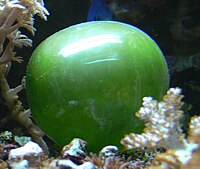
Photo from wikipedia
The central Arctic Ocean and its microbial ecosystem are shifting towards variable states due to climate change. In this study, diverse microbial eukaryotes belonging to Alveolata, Chlorophyta, Stramenopile, Telonemia, Picobiliphyta,… Click to show full abstract
The central Arctic Ocean and its microbial ecosystem are shifting towards variable states due to climate change. In this study, diverse microbial eukaryotes belonging to Alveolata, Chlorophyta, Stramenopile, Telonemia, Picobiliphyta, Cercozoa, Choanoflagellida, Fungi and Haptophyta have been identified by pyrosequencing. Canonical correspondence analysis suggested that the microbial eukaryote communities sampled from lower latitudes were significantly correlated with temperature and nutrients in sea water, whereas those from higher latitudes were correlated with conditions of ice cover, latitude of sample site and chlorophyll concentration. Picoplankton Micromonas, with a total occurrence of 17% of all reads, was the most abundant taxon. Quantification of picoprasinophytes by FISH proved their absolute predominance in the central Arctic Ocean under heavy sea ice.
Journal Title: Current Science
Year Published: 2018
Link to full text (if available)
Share on Social Media: Sign Up to like & get
recommendations!